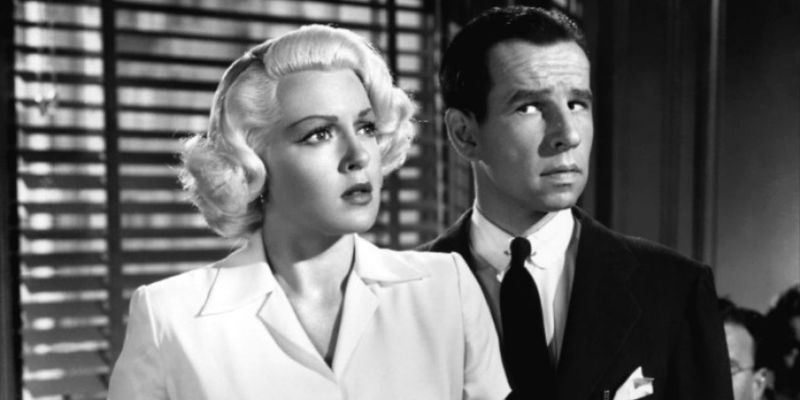James M. Cain was my gateway drug into crime fiction. Before Cain, I’d read Nelson Algren, whose novels, while often featuring criminals, would be better defined as social realism. But to my twenty-five-year-old aspiring writer self, Cain’s voice—and the reading it inspired—changed the focus of my writing horizon.
I discovered Cain through film, specifically The Postman Always Rings Twice—the original, starring Lana Turner and John Garfield, its screenplay co-written by Raymond Chandler and Billy Wilder—and eventually tracked down from the library James M. Cain: Four Complete Novels (The Postman Always Rings Twice, Mildred Pierce, Double Indemnity, and Serenade). I read them in order, and quickly.
Cain’s career in fiction writing didn’t follow the path of his being a successful short story writer and novelist before heading out to Hollywood to make his fortune. Instead, the writings for which he first became known, and which led to a lifelong friendship with H. L. Mencken, were nonfiction pieces for The Atlantic Monthly, The Nation, and The American Mercury. His first article for Mencken in The American Mercury, “The Labor Leader,” mocked both the miner and the businessman, using the vernacular of each. These so-called dialogues gave Cain the reputation as a master of spoken word, and among his admirers was Alfred A. Knopf. If he lacked the typical screenwriter’s pedigree, it was this facility with dialogue that led to his getting offers from Hollywood studios.
When he got fed up with his job at The New Yorker, he finally accepted an offer from Paramount, believing that moving west would help him solidify his voice as an author. By 1931, Cain was indeed headed for Hollywood. Unlike some of the authors who preceded him there—Faulkner, Fitzgerald, et al.—Cain had limited success as a fiction writer before he arrived, and so the charge of being a sellout didn’t apply. In fact, the opposite occurred as his literary reputation began to expand, beginning with the short story “The Baby in the Icebox,” published in The American Mercury and then sold to Paramount.
With more confidence, Cain began writing a novel based loosely two news stories he’d read—one about a female gas station attendant who ended up killing her husband, the other about a woman and her lover who conspire to murder her husband before turning on each other afterwards. Because of its length (35,000 words) and perceived problems with the ending, the novel, titled “Bar-B-Que,” was conditionally accepted by Alfred A. Knopf. After considerable back-and-forth between Cain and the publisher, the book was finally published as is save for the title. “Bar-B-Que” became “The Postman Always Rings Twice.”
Upon its release in 1934, Postman went—and there is no other word to better describe it—viral, with rave reviews on both sides of the Atlantic and best seller status for hardcover and paperback editions, along with adaptations for serial, stage, and screen.
Cain’s next project was an eight-part serial, its title suggested by Jim Geller, his agent, and inspired by his own experience in the insurance industry. Titled “Double Indemnity,” the story was rejected by Redbook but eventually bought by Liberty. Like Postman, Double Indemnity went viral, if in a different way: people lined up to purchase the next issue of Liberty as soon as it was out.
In between these successes, Cain spent time, much less successfully, on other writings. If he didn’t see these outlets as a hindrance to his novel writing, Alfred A. Knopf, his publisher of Postman did: “You can’t write fiction with one eye on the movies. … How much money would it take to persuade you to drop everything and do this book [meaning his next novel]?”
Cain didn’t answer but did eventually produce Serenade (1937), a book as sensational as its predecessors, but one that did not sell as well. Mildred Pierce, Serenade’s follow-up, appeared in 1941. Unlike the earlier three works, it was written in third person (one of only three such novels in Cain’s lifetime) and was much longer; also unlike those three, it was not initially the publishing sensation of its predecessors.
But of the four novels in the collection, I remembered details in Mildred Pierce the best. In one chapter, Mildred practices balancing plates at home to improve her waitressing skills. Far from being superficial, this scene reveals Mildred’s determination and drive, as well as her self-awareness, and it also shows that Cain, as always, had done his research.
Cain spent many years in Hollywood, but received only three screen credits. Most of his income there came from work on other scripts and from the sales of his own fiction to various studios. His last novel, The Cocktail Waitress, was published posthumously by Hard Case Crime in 2012. Cain began writing it in 1975, when he was 83, but it remained incomplete at the time of his death. Edited by Charles Ardai based on Cain’s various drafts and notes, The Cocktail Waitress represents, as Ardai points out in the Afterword, when Cain “decided to go back to his roots and write a James M. Cain novel again.”
There’s no way of knowing how many future authors Cain inspired. Ardai writes that without James M. Cain, there would be no Hard Case Crime. And without James M. Cain, it would have taken me far longer to find my way to writing crime fiction, if I got there at all. For if I’d initially embraced the laconic, cynical persona of Philip Marlow in my first crime fiction efforts, Cain’s prose and characters were surely living in my subconscious, because when I finally started writing from the perspective of people caught up in crime, I felt liberated.
Author’s note: The quote from Alfred A. Knopf and the biographical details of Cain’s writing life are taken from Ray Hoopes, Cain: The Biography of James M. Cain (New York: Holt, Rinehart and Winston, 1982).
***


















